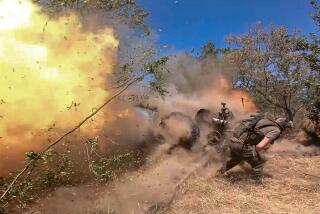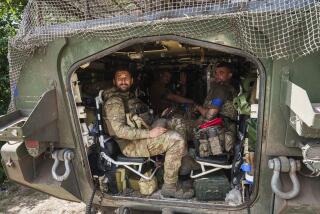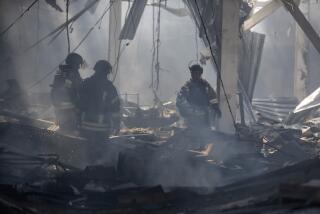Echoes of Blitzkrieg in Massive Invasion : Military history: Powerful strikes call to mind Hitler’s tactics, D-Day in Europe, Israel’s Six-Day War, Korea.
- Share via
WASHINGTON — Exploiting mobility and massive use of air power and armor, the allied invasion of Kuwait resembles the German blitzkrieg that rolled over Poland and smashed Belgium, Holland and France in the early days of World War II.
As was the case in the Germans’ “lightning war,” the speed and shock of the allied attack are intended not only to destroy the enemy’s defenses but also to wear down his morale and will to resist, spurring wholesale surrenders of Iraqi soldiers.
Intense bombardment by allied aircraft and U.S. naval vessels preceded the ground war in the Gulf, echoing the Germans’ use of screaming dive bombers and ahead of advancing panzer divisions to shatter their opponents’ confidence more than half a century ago.
Military historians said that the initial U.S.-led assault Sunday also recalled Israel’s swift victory in the Six-Day War of 1967, when Arab forces were staggered by the one-two knockout punches of Israeli air strikes and armored attacks in lightning-fast desert warfare.
“The closest comparison is the 1967 war,” said Trevor N. Dupuy, a leading military historian. “Israel had complete control of the air. The Arab troops were not bad troops, but they were totally demoralized by Israeli air power and mobility.”
But Dupuy agreed that the allied display of overwhelming military power in the Persian Gulf also reflects the blitzkrieg tactics first demonstrated by Adolf Hitler’s armies at the outset of World War II.
In his encyclopedia of military history, Dupuy described the German invasion of Poland on Sept. 1, 1939, in terms that bear a remarkable resemblance to reports of the American-led offensive launched at about 4 a.m. Sunday, Persian Gulf time:
“German armored spearheads slashed through the thin screen of six Polish armies, some 800,000 men . . . like knives through butter. . . . All communications between general headquarters and the field armies was ended. . . . Poland was paralyzed, its civilian population terrified.”
By Oct. 5, 1939, Polish resistance was crushed, owing also to the Soviet invasion of Poland in mid-September, and only guerrillas were left to oppose the Nazi and Soviet occupation forces. Similarly, the combination of formidable armor and air power allowed German troops to storm through the Netherlands and Belgium in May, 1940. Both countries capitulated in a matter of days. The power of the blitzkrieg also forced the evacuation of the British army at Dunkirk and put German troops in Paris by June 14, 1940.
Judging from sketchy information made public so far, the allies are using airborne troops to leapfrog Iraqi fixed defenses, just as Germany did in the Low Countries and in other nations it conquered with ruthless efficiency.
Initial reports from the Gulf indicate that the United States and its coalition partners mobilized as many as 200,000 troops to launch the ground war--about the same number that went ashore on Normandy beaches in 1944 in the invasion of Europe.
But the first bulletins from the Gulf battlefront reported far more rapid progress in the early hours of the assault than the World War II allies managed against a determined German defense along 150 miles of the French coast on June 6, 1944.
Assembling 5,000 ships and an air armada of more than 10,000 planes, the allies put 60,000 troops ashore at five beaches and landed paratroops at three locations behind the German lines on D-Day.
The fighting was fiercest on Omaha Beach, where units of the 1st Division suffered 2,000 casualties when high seas disrupted the landings and they encountered stiff resistance from an elite German division.
Altogether, about 10,000 American, British and Canadian troops were killed or wounded during the first 24 hours of the invasion. That compares with extremely light allied casualties reported on the first day of fighting in the Persian Gulf.
After landing on the beaches of Normandy in 1944, the allied forces fought their way across hedgerows for more than two months before they were able to declare the campaign a success.
The reported speed of the allied advance into Kuwait and parts of Iraq were comparable to the rapid advances made by U.S. troops after their amphibious invasion of Inchon during the Korean War. That successful operation turned the tide of battle against North Korea in 1950.
Landing well behind enemy lines with the advantage of complete surprise, the American forces recaptured the Korean capital of Seoul within a few days, took more than 125,000 North Korean prisoners and shattered enemy morale.
While the Inchon landing led to a successful offensive that brought U.S. forces to the banks of the Yalu River on the border with China, the entrance of Chinese troops into the war led to a standoff and resulted in the continuation of separate North and South Koreas.
More to Read
Sign up for Essential California
The most important California stories and recommendations in your inbox every morning.
You may occasionally receive promotional content from the Los Angeles Times.












